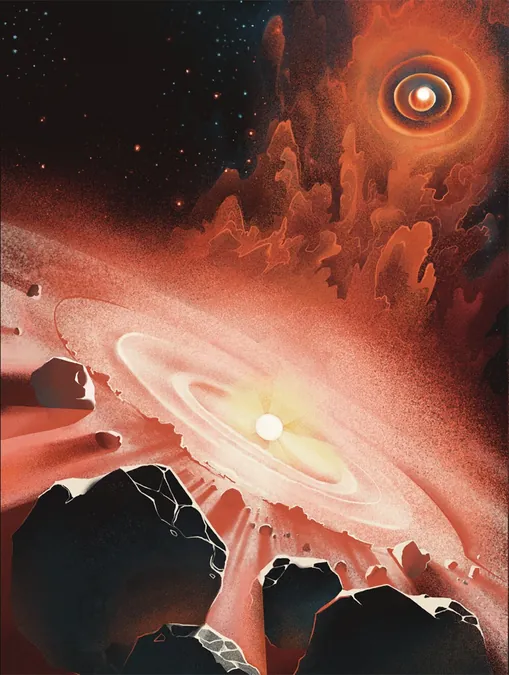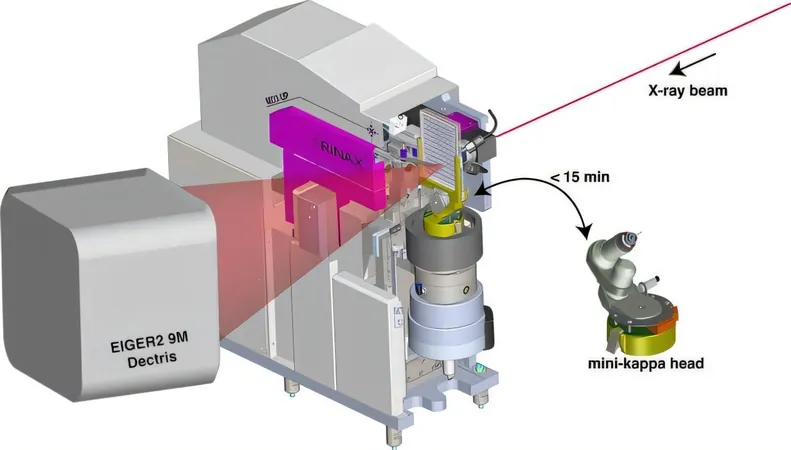
Scientists Uncover Secrets of the Sun’s Birth Through Exotic Beta Decay Measurement of Thallium
2024-11-14
Author: Emily
Introduction
Have you ever pondered the mystery of how long the sun took to form in its stellar nursery? Thanks to an international team of researchers, we are now one step closer to unraveling this cosmic conundrum. They have successfully measured the bound-state beta decay of fully-ionized thallium (²⁰⁵Tl⁸⁹) ions at the GSI/FAIR's Experimental Storage Ring (ESR), providing crucial insights into the formation timeline of our sun.
Significant Implications
This breakthrough—published in the prestigious journal *Nature*—holds significant implications for understanding the production of radioactive lead (²⁰⁵Pb) in asymptotic giant branch (AGB) stars, the very sites where elements like lead are forged. Current scientific estimates suggest that the sun formed about 10 to 20 million years after the progenitor molecular cloud began condensing, driven by processes occurring in nearby AGB stars that operated the "s-process," or slow neutron capture process.
Radioactive Imprints
These long-lived radionuclides, formed just before the sun's birth 4.6 billion years ago, leave identifiable imprints in meteorites, providing scientists a means to understand the solar system's genesis. The hunt now is for radionuclides that were exclusively produced by the s-process and unaffected by other nucleosynthesis processes. Here, ²⁰⁵Pb emerges as the prime candidate.
Decay Mechanism
In essence, ²⁰⁵Pb decays into ²⁰⁵Tl by converting a proton and an electron into a neutron and an electron neutrino in a process that favors the decay due to a minimal energy difference between the two isotopes. However, in AGB stars, where heat reaches a staggering few hundred million Kelvin, the role reverses: ²⁰⁵Tl can decay back into ²⁰⁵Pb when all electrons are stripped away, and this transformation is pivotal for calculating the amount of ²⁰⁵Pb produced.
Research Collaboration
The team behind this research, comprised of 37 institutions across 12 countries, faced numerous engineering challenges. As Professor Yury Litvinov of GSI/FAIR noted, “The measurement of ²⁰⁵Tl had been proposed in the 1980s, taking decades of accelerator development and the hard work of many colleagues to finally bring it to fruition.” The experiment involved innovative techniques to produce and isolate bare ²⁰⁵Tl nuclei, culminating in groundbreaking findings about the decay rate, which enhances our understanding of stellar processes.
Implications for AGB Stars
Dr. Riccardo Mancino elaborated on the implications of their findings, stating, “Knowing the transition strength allows us to accurately calculate the rates at which the ²⁰⁵Tl–²⁰⁵Pb pair operates in AGB stars.” Collaborators from the Konkoly Observatory in Hungary, the INAF Osservatorio d'Abruzzo in Italy, and the University of Hull in the UK have utilized these rates to model the production of ²⁰⁵Pb in AGB stars accurately.
Predictive Confidence
Dr. Maria Lugaro from Konkoly Observatory explained, “Our new decay rate allows for confident predictions regarding the amount of ²⁰⁵Pb produced in AGB stars and how it contributed to the gas cloud that ultimately formed our sun.” When juxtaposed with meteorite data, the results indicate a formation period for the sun of 10 to 20 million years from the molecular cloud.
Scientific Collaboration
As Guy Leckenby, a doctoral student and first author, emphasized, “Our result showcases the power of collaborative scientific endeavors and advanced experimental setups to decipher stellar processes.” The determined half-life of the bound-state beta decay is vital for further analysis of ²⁰⁵Pb accumulation in the interstellar medium. Yet, additional research into related nuclear reactions, like the neutron capture on ²⁰⁵Pb, is anticipated.
Conclusion
This monumental work highlights the extraordinary capabilities of facilities like GSI/FAIR, allowing scientists to replicate and study cosmic phenomena right here on Earth. By piecing together these foundational building blocks of knowledge, we come a step closer to comprehending not just the birth of our sun but the intricate workings of the cosmos itself.
Looking Ahead
What other enigmas of the universe lie waiting to be deciphered? Stay tuned as scientists continue their quest to unlock the mysteries of the stars!









 Brasil (PT)
Brasil (PT)
 Canada (EN)
Canada (EN)
 Chile (ES)
Chile (ES)
 España (ES)
España (ES)
 France (FR)
France (FR)
 Hong Kong (EN)
Hong Kong (EN)
 Italia (IT)
Italia (IT)
 日本 (JA)
日本 (JA)
 Magyarország (HU)
Magyarország (HU)
 Norge (NO)
Norge (NO)
 Polska (PL)
Polska (PL)
 Schweiz (DE)
Schweiz (DE)
 Singapore (EN)
Singapore (EN)
 Sverige (SV)
Sverige (SV)
 Suomi (FI)
Suomi (FI)
 Türkiye (TR)
Türkiye (TR)